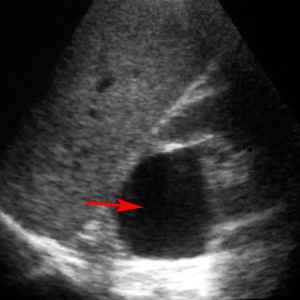

MedFriendly®


Anechoic
Anechoic means being without an echo or appearing
without echoes. The term is usually used in medicine
when discussing images of body parts that appear
black on ultrasound scans, meaning that they do not
produce echoes. An example of an anechoic structure
on ultrasound scanning would be the urinary bladder
filled with urine. Ultrasound scanning is a procedure that
uses high-frequency sound waves to produce images of
internal body structures. The sound waves bounce off
internal body parts and reflect back as an echo to a
computer, which produces an image.
Structures that produce echoes on ultrasound appear
as varying shades of gray. Specifically, body structures
that are less reflective and produce a lower amount of
echoes are known as hypoechoic and appear as darker
shades of gray.
An anechoic area in
ultrasound, denoted by the red
arrow.
FEATURED BOOK: Ultrasound Scanning
Conversely, body structures that are more reflective and produce a higher amount of
echoes are known as hyperechoic and appear as lighter shades of gray. The opposite of
anechoic is echogenic which refers to the ability of a structure to produce echoes.
Anechoic means the same thing as echo-free. Anechoic comes from the Greek word "an"
meaning "without," the Greek word "echo" meaning sound, "and the Greek word "ikos"
meaning "pertaining to." Put the words together and you have "pertaining to without
sound."
"Where Medical Information is Easy to Understand"™















